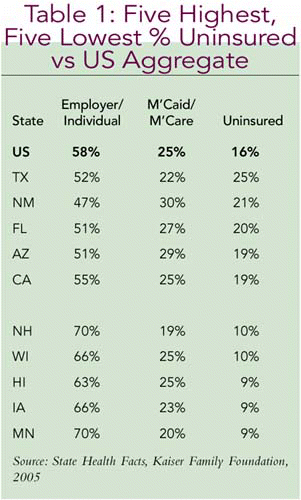With the federal government shouldering 45% of health care costs through five huge entitlements (see ENToday, April 2007) and a large federal deficit, the chance of politicians enacting a new federal entitlement for universal health insurance coverage is as likely as their conducting a smear-free political campaign. Absent a federal single payer system, states are going their own ways to expand coverage for their uninsured.
Explore This Issue
May 2007States are tailoring plans for universal coverage to their mix of demographics, politics, and health system components. They aim toward universal access and coverage, public subsidies for the working poor, with insurance including all state-mandated benefits. Common elements of state plans are freezing hospital and physician pay, offering plans with all state-mandated benefits covered, guaranteed issue, reliance on information technology for reporting, and forcing employers and/or individuals to either purchase insurance or pay penalties (see www.nahu.org/legislative/tools/state_mandates ).
To get a broad perspective on states’ attempts to cover their uninsured, looking at the percentage of uninsured reveals some significant demographic trends that may be overlooked when legislators design their programs to cover the uninsured (see Table 1). The states with the highest number of uninsured-Texas, New Mexico, Florida, Arizona, and California-all have large illegal immigrant populations. Additionally, their temperate climates and relatively attractive state tax rates entice large numbers of seniors. So the findings that the five states with the highest percentage of uninsured have only an average of 51.2% covered by employer/individual insurance, versus 67% for the states with the lowest percentage of uninsured, isn’t surprising. Illegal immigrants tend to not have employer-sponsored insurance. As for the 26.6% Medicaid/Medicare recipients in the five worst states, versus 22.4% for the five best states, that’s not surprising either. Logically, states with large numbers of illegal immigrants and seniors have more Medicaid and Medicare enrollees than states with larger percentages of employer-sponsored insurance.
Demographics tell a large part but not the entire story. The Council on Affordable Health Insurance (CAHI) index provides snapshots of each state’s health insurance environment. A high score indicates a competitive affordable market. By this measure, Alabama, Iowa, Idaho, Kansas, Kentucky, Minnesota, Mississippi, and Nebraska are best. States that CAHI says undermine consumer choice are Delaware, Massachusetts, Maine, New Jersey, New York, North Carolina, Tennessee, and Vermont. Perhaps that explains why Massachusetts, Maine, Tennessee and Vermont have been busy trying to fix their noncompetitive and expensive health insurance systems.


Leave a Reply